Neonatal healthcare-associated infections in Brazil: systematic review and meta-analysis
- PMID: 34074325
- PMCID: PMC8167304
- DOI: 10.1186/s13690-021-00611-6
Neonatal healthcare-associated infections in Brazil: systematic review and meta-analysis
Abstract
Background: Healthcare-associated infections (HAI) are important causes of neonatal morbidity and mortality in developing countries. We reviewed the incidence and the pathogens involved in HAI among infants admitted to neonatal intensive care units (NICU) in Brazil.
Methods: A search was conducted in the MEDLINE, LILACS and SciELO databases from January 1995 to October 2019. Two authors scrutinized potential articles independently, after one author selected them from screening abstracts from every article flagged as related to neonatal HAI. Then, they were included in the review if they met our inclusion criteria. The studies were evaluated based on a quality score proposed by the authors, rated 0 to 1, with 1 point as the best quality rate. Pooled estimates and 95% confidence intervals (95% CI) for HAI cumulative incidence and incidence density were calculated, when the same denominators were available, using meta-analysis. A quality effect was applied to the models using the MetaXL software. Heterogeneity was assessed using I2 statistics and the Cochran's Q test.
Results: Of a total of 5596 citations identified, 15 studies met the inclusion criteria for this review, which comprised 24,408 patients and 312,744 patient-days. Quality of the studies varied between 0.36 and 1 according to the adopted score, and six (40.0%) studies presented a score of 1. Pooled HAI incidence was 36.1 (95% CI 22.8-50.7) infections and 26.3 (95% CI 18.4-35.0) infected patients per 100 patients. Pooled HAI incidence density was 23.5 (95% CI 16.3-33.9) per 1000 patient-days. Pooled incidence density rates of bloodstream infection and ventilator-associated pneumonia were 13.1 per 1000 catheter-days (95% CI 4.3-40.1) and 7.9 per 1000 ventilator-days (95% CI 1.1-55.5), respectively. A high degree of heterogeneity was observed in all models (I2 > 98% and Cochran's Q test with p < 0.05). Coagulase-negative Staphylococci (32.1%), Staphylococcus aureus (13.8%) and Klebsiella spp. (12.4%) were the most prevalent causative bacterial pathogens.
Conclusions: The findings show high incidence of neonatal HAI in Brazilian NICU; therefore, efforts to standardize the collection and notification of HAI are needed in order to strengthen surveillance in the country and implement preventive measures, routine assessment, and close monitoring of neonates.
Keywords: Brazil; Healthcare-associated infections; Meta-analysis; Neonatal sepsis.
Conflict of interest statement
The authors declare that they have no competing interests.
Figures



Similar articles
-
A Systemic Review and Meta-analysis of the Leading Pathogens Causing Neonatal Sepsis in Developing Countries.Biomed Res Int. 2021 Jun 5;2021:6626983. doi: 10.1155/2021/6626983. eCollection 2021. Biomed Res Int. 2021. PMID: 34195273 Free PMC article.
-
Healthcare-associated infections among neonates in Brazil.Infect Control Hosp Epidemiol. 2004 Sep;25(9):772-7. doi: 10.1086/502475. Infect Control Hosp Epidemiol. 2004. PMID: 15484803
-
Neonatal sepsis in Iran: A systematic review and meta-analysis on national prevalence and causative pathogens.PLoS One. 2020 Jan 24;15(1):e0227570. doi: 10.1371/journal.pone.0227570. eCollection 2020. PLoS One. 2020. PMID: 31978069 Free PMC article.
-
Nosocomial infections in a neonatal intensive care unit during 16 years: 1997-2012.Rev Soc Bras Med Trop. 2014 May-Jun;47(3):321-6. doi: 10.1590/0037-8682-0101-2014. Rev Soc Bras Med Trop. 2014. PMID: 25075483
-
Device-associated infections rates in adult, pediatric, and neonatal intensive care units of hospitals in the Philippines: International Nosocomial Infection Control Consortium (INICC) findings.Am J Infect Control. 2011 Sep;39(7):548-54. doi: 10.1016/j.ajic.2010.10.018. Epub 2011 May 26. Am J Infect Control. 2011. PMID: 21616564
Cited by
-
Evaluation of Biofilm Formation and Prevalence of Multidrug-Resistant Strains of Staphylococcus epidermidis Isolated from Neonates with Sepsis in Southern Poland.Pathogens. 2021 Jul 11;10(7):877. doi: 10.3390/pathogens10070877. Pathogens. 2021. PMID: 34358027 Free PMC article.
-
Development and Validation of a Nosocomial Infection Nomogram Model in the NICU: A Novel and Nurse-Led Way to Prediction in Preterm Infants.Infect Drug Resist. 2025 Jan 29;18:589-599. doi: 10.2147/IDR.S486290. eCollection 2025. Infect Drug Resist. 2025. PMID: 39898355 Free PMC article.
-
Ventilator-Associated Pneumonia in the Neonatal Intensive Care Unit-Incidence and Strategies for Prevention.Diagnostics (Basel). 2024 Jan 23;14(3):240. doi: 10.3390/diagnostics14030240. Diagnostics (Basel). 2024. PMID: 38337756 Free PMC article. Review.
References
-
- Barros FC, Matijasevich A, Requejo JH, Giugliani E, Maranhão AG, Monteiro CA, Barros AJD, Bustreo F, Merialdi M, Victora CG. Recent trends in maternal, newborn, and child health in Brazil: progress toward millennium development goals 4 and 5. Am J Public Health. 2010;100(10):1877–1889. doi: 10.2105/AJPH.2010.196816. - DOI - PMC - PubMed
-
- Brasil. Ministério da Saúde. Secretaria de Vigilância em Saúde. Departamento de Vigilância de Doenças e Agravos não Transmissíveis e Promoção da Saúde . Saúde Brasil 2018: uma análise de situação de saúde e das doenças e agravos crônicos: desafios e perspectivas. Brasília: Ministério da Saúde; 2019. Cap. 2: Evolução e principais causas da mortalidade na infância e componentes nas regiões brasileiras entre 2010 e 2016; pp. 33–58.
-
- United Nations . Transforming our world: the 2030 agenda for sustainable development. New York: United Nations; 2015.
Publication types
LinkOut - more resources
Full Text Sources
Miscellaneous

